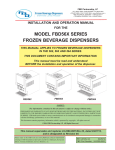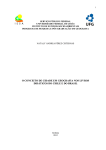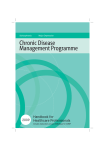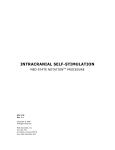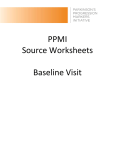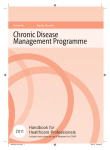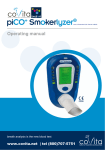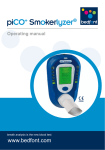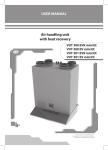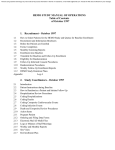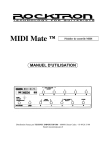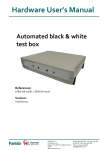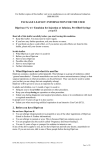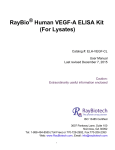Download Chronic Disease Management Programme
Transcript
Chronic Disease Management Programme Diabetes Mellitus Hypertension Lipid Disorders Stroke Asthma COPD Schizophrenia Major Depression Dementia Bipolar Disorder Osteoarthritis BPH Anxiety Parkinson’s Disease Nephritis/Nephrosis Handbook for Healthcare Professionals 2014 (Includes the use of Medisave for CDMP and clinical components of Community Health Assist Scheme (CHAS)) 1 CONTENTS CHAPTER ONE: The Chronic Disease Management Programme (CDMP) ................................... Overview-Update Clinical Guidelines and Clinical Data Submission Shared Care Programme for CDMP Mental Illnesses (CDMP-MI) Medisave use under CDMP CHAPTER TWO: The Clinical Guidelines Reportable Conditions Non-Reportable Conditions CHAPTER THREE: Registration and Medisave Use .................................................................... Policy on Medisave Use Registration Process for Medisave for CDMP Guidelines on Medisave Use for CDMP Process of Making a Medisave Claim Audit CHAPTER FOUR: Capture and Submission of Clinical Data ........................................................ Commencement of Clinical Data Collection Collection and Submission of Clinical Data Deadlines for Submission of Clinical Data to MOH CHAPTER FIVE: User Manual for Clinical Data Submission via CIDC e-Service............................ Introduction Getting Started Clinical Indicators Report Submission Patient Details Known Medical History Clinical Indicators and Assessment Attending Physician Information Report Submission Search Clinical Indicator Reports CIDC Clinic Reports Troubleshooting Fallback Procedures Contact Information for Queries Related to Clinical Data Collection and Submission CHAPTER SIX: Frequently Asked Questions ............................................................................. Clinical Matters Registration Matters Medisave Claims, Reimbursement, Billing Data Submission, Clinical Improvement and Audits 2 CHAPTER ONE: The Chronic Disease Management Programme (CDMP) INTRODUCTION This handbook provides an update on one of the key programmes from the Ministry of Health (MOH) to better manage chronic conditions in the community – the Chronic Disease Management Programme (CDMP). The handbook is organized into three sections: a) Section 1 (Chapter One) provides an updated overview, summarizing the key past and recent changes relevant to the CDMP; b) Section 2 (Chapter Two) provides a disease-by-disease guide on the respective clinical indicators, indications for referral, and diseasespecific claimable and non-claimable items; c) Section 3 (Chapters Three to Six) provides a one-stop reference for administrative matters related to the CDMP; Overview-Update 1 Method of Payment Medisave for CDMP Medisave CHAS Subsidy (for eligible persons) Disease Coverage - Acute Not applicable to acute conditions All acute conditions Except for non-ISP screening tests, aesthetic and lifestyle treatments (Applicable only to Blue Health Assist cardholders) - Chronic Claims/Data Submission Portal 15 identified chronic conditions claimable under either or both schemes Mediclaim eCHAS * When claims are made for both Medisave for CDMP and CHAS, clinical indicators only need to be submitted once through either Mediclaim or eCHAS. 1.1 The Chronic Disease Management Programme (CDMP) forms the clinical core of the management of patients with chronic conditions in the community. It includes: (a) evidence-based, structured Disease Management Programmes1 (DMPs), where applicable and (b) option for patients to either tap on subsidy (e.g. CHAS) or draw on their Medisave to help reduce out-of-pocket payments for outpatient treatment 1 Components of disease management include: (a) population identification process; (b) evidencebased practice guidelines; (c) Collaborative practice models to include physician and support-service providers; (d) Patient self-management education; (e) Process and outcome measurement, evaluation, and management; (f) Routine reporting/feedback loop (both at the primary care and specialist settings) required in the management of their chronic conditions. It supports the Ministry’s vision of encouraging ‘One Family Physician for Every Singaporean.’ Patients who have been seeing their family doctor can continue to see their preferred doctor as they age and develop chronic conditions. 1.2 When the CDMP was first introduced in 2006, it started with Diabetes Mellitus. Since then, more common chronic conditions with internationally established treatment protocols and clear measurable clinical outcomes such as Hypertension and Lipid Disorders were progressively included. Subsequently, CDMP was also extended to include outpatient psychiatric treatment for patients with Schizophrenia, Major Depression, Dementia and Bipolar Disorder. 1.3 From January 2014, Medisave use and CHAS subsidies for chronic conditions was further extended beyond conditions that traditionally benefited from DMPs (e.g. Diabetes Mellitus), to include chronic conditions with relatively high disease burdens (e.g. Osteoarthritis). This helps these patients reduce out-of-pocket payments. Table 1 below lists the conditions under CDMP/CHAS as of January 2014, with the newly introduced conditions in bold. Table 1: Chronic Conditions under CDMP/CHAS Chronic Conditions with CDMP-Mental Illnesses Other Chronic Conditions (Requiring participation of Established DMPs (Requiring the reporting of indicators) 1) Diabetes Mellitus 2) Hypertension 3) Lipid Disorders 4) Asthma 5) Chronic Obstructive Pulmonary Disease (COPD) 6) Nephritis/Nephrosis 2 clinic/doctor in a Shared Care Programme) 7) Schizophrenia 8) Major Depression 9) Bipolar Disorder 10) Anxiety 11) Stroke 12) Dementia 13) Osteoarthritis 14) Parkinson’s Disease 15) Benign Prostatic Hyperplasia (BPH) Clinical Guidelines and Clinical Data Submission 2.1 Participating clinics/medical institutions are expected to provide care to patients in line with the latest Clinical Practice Guidelines (CPG) and/or best available evidence-based practice, as well as to track clinical data at patient and clinic/ medical institution level to monitor patient outcome. While participating clinics/medical institutions will still be required to submit relevant clinical indicators, MOH has revised the requirement for clinical data submission to only 6 of the 15 conditions under CDMP. For the other 9 conditions, essential care components are expected to be documented and may be subjected to periodic audits. 2.2 Please refer to Chapter Two: The Clinical Guidelines for further details on the essential care components, indications for referral and specific examples of 4 claimable/non-claimable items. These are recommended by Subject-Matter-Experts based on best available medical evidence. The list of clinical indicators to be submitted is detailed in Chapter Four: Capture and Submission of Clinical Data. 2.3 Patients often have one or more of the 3 common metabolic and cardiovascular diseases, namely Diabetes Mellitus, Hypertension and Lipid Disorders. For these patients, they should be enrolled into the respective Disease Management Programme (DMP) according to Annex A (page 7). 3 Shared Care Programme for CDMP Mental Illnesses (CDMP-MI) 3.1 Mental health conditions, i.e. Schizophrenia, Major Depression, Bipolar Disorder and Anxiety, are included in the CDMP-MI. Doctors interested in making Medisave claims for the above-mentioned conditions are required to attend training updates for CDMP-MI, and participate in a Shared Care Programme with a public hospital to ensure that they have sufficient training and confidence in treating patients with mental health conditions. Please refer to point 1.3 in Chapter Three: Registration and Medisave Use for more details. 3.2 Dementia will not be considered as a CDMP-MI condition as of 1 Jan 2014, and therefore physicians who wish to manage Dementia under CDMP are not required to participate in the Shared Care Programme. 4 Medisave use under CDMP 4.1 Only doctors and clinics/medical institutions which are accredited for Medisave use and participating in the CDMP can make Medisave claims. 4.2 Medisave can be used to pay for the essential care components in the management of that specific DMP or for the treatment of the approved conditions in Table 1 and its complications. Some items such as sleeping pills, slimming pills and erectile dysfunction drugs are not Medisave-claimable. This is to ensure judicious usage of patients’ Medisave dollars so that they cover essential care components and medications. Physicians too have a responsibility to safe-guard patients’ Medisave accounts to avoid premature depletion and to achieve cost-effective care for the patient. A general list of claimable and non-claimable items/services can be found in Table 3 in Chapter Three: Registration and Medisave Use. 4.3 The maximum amount that can be withdrawn for chronic disease treatments/attendances taking place in the year 2012 and thereafter is $400 per Medisave account per calendar year. 4.4 Withdrawals may be made from more than one Medisave account in any given year. For example, the patient may use his/her own Medisave account, as well as the Medisave accounts of any of his/her immediate family members to pay for his/her chronic disease treatments. Immediate family members refer to parents, spouses and children. Patients who are Singapore Citizens or Permanent Residents 5 will also be able to use their grandchildren’s Medisave to pay for their treatments. Please see Chapter Three: Registration and Medisave Use for more information. 4.5 Please refer to the following summary for the use of Medisave: Patient has one or more of the 15 chronic diseases (See Chapter 1) Visits a clinic/doctor who is registered with “Medisave for CDMP” (See Chapter 3) Patient is counselled on how he/she can draw on his/her or his/her family members’ Medisave (max of $400 per account per year) to help pay for management of these chronic disease(s) (See Chapter 3) Patient consents and signs the Medisave Authorisation Form Patient is enrolled into the relevant Programmes (See Chapter 2) Submit Clinical Data of Patient. (See Chapters 2, 4 & 5) Submit Medisave Claim for Patient. (See Chapter 3) (i) Data submitted reflects essential clinical care components in management of the chronic disease(s). (ii) Feedback on aggregated data to clinic allows comparison & selfassessment of clinic’s performance and identify areas in need of quality improvement. (i) Allows patient to draw from his/her own or his/her family member’s Medisave account(s) for outpatient treatment. (ii) Leads to reduction in “outof-pocket” payment upfront. 6 Annex A Enrolling patients with Diabetes Mellitus, Hypertension, Lipid Disorders and/or Stroke DM? Yes Diabetes Mellitus DMP No HPT? Yes Hypertension DMP No HL? Yes Lipid Disorders DMP 7 CHAPTER TWO: The Clinical Guidelines – *Reportable Conditions * Regular data submission is required for these 6 conditions based on their Clinical Indicators Diabetes Mellitus 1 Part I: Clinical Indicators Essential Components • • Glycated Haemoglobin (HbA1c) Recommended Frequency Remarks (*more frequent if clinically indicated) General HbA1c target of ≤7.0%, but target of Twice a year Blood Pressure Measurement Twice a year Weight and BMI Assessment Twice a year Lipid Profile Annually Nephropathy Assessment Serum Cr and eGFR, and Urine Albumin-Creatinine (uACR) Annually Eye Assessment Annually Foot Assessment Annually Smoking Assessment Annually Cardiac Assessment At diagnosis before initiating medications, and as clinically indicated treatment should be personalised (e.g. for elderly) General BP target of <140/90 mmHg, but target of treatment should be personalised (e.g. for patients with Nephropathy) 2 Keep <25kg/m (For Asian population, keep 2 BMI < 23 kg/m ). All patients should be risk stratified (as recommended in the Lipids CPG) Targets of treatment should be personalised by levels of risk Good glycaemic control and good BP control with Angiotensin Converting Enzyme (ACE) inhibitor or Angiotensin Receptor Blocker (ARB) preferred to slow progression of Diabetic Nephropathy. Submission of readings of Cr, eGFR, uACR required only for patients with Nephropathy. Includes retinal photography and visual acuity Patients with T1 DM: First assessment within 3-5 years after diagnosis of diabetes once patient is aged ten years or older. Patients with T2 DM: First assessment at diagnosis. Screen for peripheral neuropathy, peripheral vascular disease, or bone, joint, skin and nail abnormalities Estimated sticks/day (zero for non- or exsmoker) Includes baseline ECG 8 Part II: Suggested Indications for Referrals Referral from Primary Care to Specialist Special Patient Population High Risk Individuals DM Complications Requiring Active Sub-Specialist Management Adults with suspected Type 1 DM Children and adolescents with suspected DM (regardless of type) Pregnant women or those planning pregnancy who require pre-conception intensive glycaemic control Patients with morbid obesity who are open to the option of intensive weight management including bariatric surgery Individuals with or at risk for recurrent * severe hypoglycaemia, diabetic ketoacidosis (DKA) or hyperglycaemic hyperosmolar state (HHS) regardless of HbA1c High risk patients who may benefit from intensive control of blood glucose and/or other risk factors (e.g. to retard progression of retinopathy or nephropathy) * Severe hypoglycaemia refers to hypoglycaemia where assistance from another person is required. Nephrology referral if any of the following: o Unexpected or rapid decline in renal function o Difficult management issues (blood pressure, hyperkalaemia control) o Atypical features (e.g. haematuria, presence of casts in the urine sediment, presence of renal bruit, nephritic range proteinuria (>3g/day), absence of retinopathy) Ophthalmology referral if any of the following: o Hard exudates/retinal thickening within one disc diameter of the fovea (diabetic macular oedema) o Severe non-proliferative diabetic retinopathy o Unexplained drop in visual acuity/eye findings Early referrals o Neovascularisation from proliferative diabetic retinopathy o Pre-retinal and/or vitreous haemorrhage o Rubeosis iridis (new vessels on the iris) Urgent referrals o Sudden loss of vision o Retinal detachment o Neovascular glaucoma Foot-care team (podiatry, orthopaedics surgery, vascular surgery) if any of the following: o Ulceration, gangrene, severe foot infection o Suspected acute Charcot’s foot o Vascular claudication 9 Part III: Claimable/Non-Claimable Items Specific Examples of Claimable/Non-Claimable Items: Where appropriate, drugs related to complications, e.g. Ischaemic Heart Disease, Chronic Renal Failure, Neuropathic pains (e.g. Amitriptyline and Carbamazepine) and Peripheral Vascular Diseases (e.g. Pentoxifylline) are claimable. Weight management and lifestyle management programmes are not claimable. Slimming pills and drugs for erectile dysfunction are not claimable. Supplements such as Vitamin B/B12 are non-claimable unless actual deficiency is documented. 10 Hypertension 2 Part I: Clinical Indicators Essential Components Blood Pressure Measurement Recommended Frequency Remarks (*more frequent if clinically indicated) General BP Twice a year Weight and BMI Assessment Twice a year Smoking Assessment Annually Lipid Profile At or soon after diagnosis, and as clinically indicated Cardiac Assessment At diagnosis before initiating medications, and as clinically indicated target of ≤140/90 mmHg, but target of treatment should be personalised 2 Keep BMI <25kg/m .(For Asian population, 2 keep BMI < 23 kg/m ). Estimated sticks/day (zero for non- or exsmoker) All patients should be risk stratified (as recommended in the Lipids CPG) Targets of treatment should be personalised by levels of risk Includes baseline ECG Part II: Suggested Indications for Referrals Referral from Primary Care to Specialist Complex Cases Young patients who are less than 30 years old Patients suspected to have secondary causes of hypertension Patients with labile hypertension or hypertension refractory to a combination of 3 or more drugs Patients presenting with hypertensive emergencies or urgencies Part III: Claimable/Non-claimable Items Specific Examples of Claimable/Non-claimable: Purchase of blood pressure monitoring machines is not claimable. For patients with Ischaemic Heart Disease, investigations like 2D Echocardiogram, MIBI scans are claimable. 11 Lipid Disorders 3 Part I: Clinical Indicators Essential Components Lipid Profile Recommended Frequency Remarks (*more frequent if clinically indicated) All patients Annually Smoking Assessment Annually should be risk stratified (as recommended in the Lipids CPG) Targets of treatment should be personalised by levels of risk Estimated sticks/day (zero for non- or exsmoker) Part II: Suggested Indications for Referrals Referral from Primary Care to Specialist Referral to Endocrinologist Referral to Gastroenterologist Target parameters not achieved despite maximised drug therapy Triglyceride level more than 4.5mmol/L despite treatment Pre-treatment transaminases are 1.5 to 3 times above normal range Persistently high transaminases (at least 3 times above normal range) during statin therapy or when statin has been stopped Part III: Claimable/Non-Claimable Items Specific Examples of Claimable/Non-Claimable: Red yeast supplements (Hypocol) and Co-enzyme Q10 are not claimable. However, Omega 3, which is HSA registered, is claimable. 12 4 Asthma Part I: Clinical Indicators Essential Components Asthma Control Test (ACT) score Recommended Frequency Remarks (*more frequent if clinically indicated) Recommended for assessment of control at Twice a year Self-Management Education (with At diagnosis, and Written Asthma Action Plan) clinically indicated as Smoking Assessment Annually every visit Applicable for patients 4 years and above. For those below 4 years old, proper documentation (e.g. daytime or night-time symptoms, whether symptoms affect the patient’s sleep, feeding, activities) from patient’s carer is required Provide and review patient’s Written Asthma Action Plan Educate on what to do during acute exacerbations Inhaler technique assessment Estimated sticks/day (zero for non- or exsmoker) Part II: Suggested Indications for Referrals Referral from Primary Care to Specialist Presence of Co-Morbidity Cases Requiring Further Investigation High Risk Individuals Concurrent heart failure that may complicate management Psychiatric disease or multiple psychosocial problems Concurrent active GERD which may mimic asthma Uncertain diagnosis with need for additional investigations (e.g. unilateral wheeze, unable to differentiate COPD from asthma) Probable Occupational Asthma History of near-fatal asthma requiring intubation and ventilation Failed to achieve asthma control despite optimal treatment e.g. patients requiring daily oral steroids for control Severe asthma requiring step 4 care and yet experiencing exacerbation despite compliance Poorly controlled asthmatics with ≥2 hospitalisations and/or requires ≥2 courses of burst therapy with oral steroids in the past year Part III: Claimable/Non-Claimable Items Specific Examples of Claimable/Non-Claimable: Investigations done prior to diagnosis (e.g. spirometry) or unrelated to the follow-up of Asthma are not claimable. Non-evidence based investigations such as hand-held spirometry are not claimable. 13 Chronic Obstructive Pulmonary Disease (COPD) 5 Part I: Clinical Indicators Essential Components COPD Assessment Test (CAT) Score Smoking Assessment Influenza Vaccination Weight and BMI Assessment Recommended Frequency Remarks (*more frequent if clinically indicated) Annually Estimated sticks/day Annually Annually Annually Self-Management Education Spirometry (zero for non- or ex- smoker) At diagnosis, and clinically indicated as Nutritional intervention should be considered in all COPD patients with BMI 2 <18.5kg/m or significant involuntary weight loss (>10% during the last 6 months or > 5% in the past month) Educate on what to do during acute exacerbations Inhaler technique assessment At or soon after diagnosis and subsequently as clinically indicated Part II: Suggested Indications for Referrals Referral from Primary Care to Specialist Severe or Complex Cases Moderate to severe COPD (i.e. FEV1<50% predicted) Frequent exacerbations (e.g two or more a year) despite compliance to treatment Rapidly progressive course of disease Development of new symptoms (e.g. haemoptysis) or new physical signs (e.g. cyanosis, peripheral oedema) Part III: Claimable/Non-Claimable Items Specific Examples of Claimable/Non-Claimable: Medications not indicated for COPD, including mast cell stabilisers (e.g. Ketotifen) are not claimable. Investigations done prior to diagnosis (e.g. spirometry) or unrelated to the follow-up of COPD are not claimable. Non-evidence based investigations such as hand-held spirometry are not claimable. 14 6 Nephritis/Nephrosis Conditions include (a) Chronic Glomerulonephritis (presenting as nephritic or nephrotic syndromes), (b) Nephropathies (e.g. secondary to underlying diabetes or other conditions) and (c) Chronic Kidney Diseases (with or without known underlying aetiology). Part I: Clinical Indicators Essential Components Blood Pressure Measurement Recommended Frequency Remarks (*more frequent if clinically indicated) ACE-I and ARBs should be used for BP control Twice a year Renal Function – eGFR or Serum Annually Creatinine when proteinuria is present If eGFR is submitted, it should be using the MDRD formula; Serum Creatinine to be submitted for calculation (for calculation) if lab does not generate MDRD-eGFR Urinary Protein – Urine Protein Annually Creatinine Ratio (uPCR) or AlbuminCreatinine Ratio (uACR) Part II: Suggested Indications for Referrals Referral from Primary Care to Specialist Significant Proteinuria Persistent Haematuria Declining Renal Function Difficult BP Control Urine protein > 1 g/day (or its uPCR>100mg/mmol or ACR>70mg/mmol) equivalent i.e. eGFR < 45 ml/min/1.73 m² or rapid decline (> 5 ml/min/1.73 m² per year) BP>150/90mmHg despite 3 anti-hypertensive medications at maximal doses Part III: Claimable/Non-Claimable Items Specific Examples of Claimable/Non-Claimable: Supplements such as Iron/Calcium/Vitamin D are not claimable unless deficiency is proven. Unrelated or pre-diagnostic investigations e.g. myeloma panels are not claimable. Investigations that are related to Glomerulonephritis are claimable, e.g. autoimmune serological markers. Pre- and post-dialysis investigations are also claimable. The treatment of complications, such as Renal Osteodystrophy, is claimable. Treatment for dialysis complications is also claimable. Transplant-related investigations and/or procedures are not claimable. 15 CHAPTER TWO: The Clinical Guidelines - *Non-reportable Conditions *Routine online submission of clinical data for the following conditions is not required. However, clinicians are expected to provide for essential components of care as listed below. 1. Stroke Defined to include Stroke and Transient Ischemic Attack (TIA). Part I: Clinical Indicators Essential Components Thromboembolism Risk Assessment Rehabilitation Need Assessment Blood Pressure Measurement Lipid Profile Recommended Frequency Remarks (*more frequent if clinically indicated) Evaluate for As clinically indicated atrial fibrillation, cardiac murmurs and need for anti-thrombotic therapy As clinically indicated Twice a year Annually General BP target of ≤140/90 mmHg All patients should be risk stratified (as recommended in the Lipids CPG) Targets of treatment should be personalised by levels of risk Part II: Suggested Indications for Referrals Referral from Primary Care to Specialist New (suspected) onset of TIA or Stroke New onset of atrial fibrillation or cardiac murmurs requiring further evaluation Part III: Claimable/Non-Claimable Items Specific Examples of Claimable/Non-Claimable: Purchase of medical equipment such as walking aids, wheelchairs and other home nursing equipment are not claimable. Investigations done prior to diagnosis of Stroke/Transient Ischemic Attacks (e.g. CT or MRI brain) are not claimable. Supplements such as Vitamin B/B12 are non-claimable unless actual deficiency is documented. Treatment of depression in stroke is claimable. Non-HSA approved medications and nootropics (e.g. piracetam) are not claimable. Dietary supplements (e.g. Glucerna, Ensure) are not claimable. 16 2. Dementia Part I: Clinical Indicators Essential Components Assessment of Memory Recommended Frequency Remarks (*more frequent if clinically indicated) For patients Annually on cognitive enhancers, objective documentation of memory assessment with a bedside cognitive screening instrument (e.g. Mini-Mental State Examination) must be performed. Assessment of Mood and Behaviour Annually Assessment of Social Difficulties and Caregiver stress (if any) Annually Assessment and referral to appropriate community services may be required Assessment of Functional and Rehabilitation Needs Annually To assess home safety, driving safety, falls, functional decline and swallowing difficulties Part II: Suggested Indications for Referrals Referral from Primary Care to Specialist Young onset Dementia (YOD) i.e. onset before the age of 65 Patients in whom diagnosis of Dementia is uncertain Uncontrolled neuropsychiatric symptoms despite trial of medications Part III: Claimable/Non-Claimable Items Specific Examples of Claimable/Non-Claimable: Off-label/non-HSA-approved/non-evidence-based medications or therapies (e.g. NSAIDs, COX2 inhibitors and Prednisolone) for prevention of cognitive decline are not claimable. Dietary supplements (e.g. Vitamin E, Ginkgo) or traditional medications/therapies (e.g. aromatherapy or massage therapy) are not claimable. 17 3. Parkinson’s Disease Defined to include Parkinson’s Disease and Parkinsonism (excluding Druginduced Parkinsonism). Part I: Clinical Indicators Essential Components Review of Diagnosis Recommended Remarks Frequency (*more frequent if clinically indicated) The diagnosis would be reviewed regularly and reassessed if Annually Review of Treatment Annually Review of Complications Annually there are atypical features (e.g., falls at presentation and early in the disease course, poor response to levodopa, symmetry at onset, rapid progression to Hoehn & Yahr stage 3 in 3 years, lack of tremor or dysautonomia) Review and discussion with regard to medical and surgical treatment options, as well as need for rehabilitative therapies (physiotherapy, occupational therapy and speech therapy) Assessment for cognitive impairment, psychiatric disorders (e.g. depression, psychosis), autonomic dysfunction (e.g. constipation, incontinence, orthostatic hypotension), falls, sleep disorders, and medication-related side effects Part II: Suggested Indications for Referrals Referral from Primary Care to Specialist Complicated or Atypical Parkinsonism Young-onset (≤55 years old) Parkinson’s Disease Atypical Parkinsonism Patients who do not respond to levodopa or dopamine agonists Patients with cognitive impairment or neuropsychiatric dysfunction Parkinson’s disease complicated by dyskinesia, dystonia, myoclonus or gaze palsies Family history of Parkinson’s Disease Part III: Claimable/Non-Claimable Items Specific Examples of Claimable/Non-Claimable: Dietary supplements or traditional medications/therapies (e.g. CoEnzyme Q10) are not claimable. 18 4. Osteoarthritis Part I: Clinical Indicators Essential Components Recommended Frequency Remarks (*more frequent if clinically indicated) Joint Pain and Function Annually In the form of a directed or supervised Prescription and Review of Exercise Annually muscle strengthening or aerobic exercise Plan programme. Can be undertaken by Weight and BMI Assessment Annually Activities of Daily Living (ADL) Annually Assessment physiotherapist. Weight reduction should be advocated for 2 patients with BMI of ≥23 kg/m . Obese 2 patients with BMI ≥30 kg/m should be referred to a medically-supervised weight reduction programme Referral to physiotherapy/occupational therapy assessment for assisted devices made, should ADL be impaired Part II: Suggested Indications for Referrals Referral from Primary Care to Specialist Unsatisfactory improvement of pain, stability or function despite Lack of Response to adequate conservative (non-pharmacological and Conservative Treatment pharmacological) treatment Part III: Claimable/Non-Claimable Items Specific Examples of Claimable/Non-Claimable: Off-label/non-HSA-approved/non-evidence-based medications or therapies (e.g. Glucosamine, Calcium, and Intra-articular viscosupplementation, Acupuncture and Chiropractic) are not claimable. Investigations (e.g. X-ray knees) related to the management of Osteoarthritis are claimable. 19 5. Benign Prostatic Hyperplasia (BPH) Part I: Clinical Indicators Essential Components Recommended Frequency Remarks (*more frequent if clinically indicated) Recommended tool for assessment of LUTS is Review of Lower Urinary Tract Annually the - International Prostate Symptom Symptoms /Quality of Life Score Clinical Examination – Abdominal Initial assessment and Digital Rectal Exam Abdominal examination includes assessment for a palpable bladder. Rectal examination to assess size, consistency and regularity of prostate. Co-Morbidity Assessment (includes Initial assessment medication review) Urine Labstick or Microscopy Initial assessment Screen for haematuria, pyuria and glycosuria Part II: Suggested Indications for Referrals Referral from Primary Care to Specialist Retention of urine, palpable bladder and/or high residual urine Urinary incontinence and/or other persistent bothersome symptoms Haematuria Proven urinary tract infection Bladder stones Hard and/or irregular prostate Part III: Claimable/Non-Claimable Items Specific Examples of Claimable/Non-Claimable: Dietary supplements or traditional medications/therapies (e.g. Saw palmetto extract) are not claimable. PSA and Testosterone tests are not claimable. 20 6. Mental Illnesses: a) Schizophrenia, b) Major Depression, c) Bipolar Disorder and d) Anxiety * In order to provide greater support (e.g. professionally as well as drugs) for family physicians managing patients with mental illness, family physicians are required to participate in Shared Care or GP Partnership Programmes with Restructured Hospitals before Medisave claims can be made. *Anxiety disorders claimable under CDMP are General Anxiety Disorder, Panic Disorder, Phobic Anxiety Disorders, Obsessive-Compulsive Disorder, and Posttraumatic Stress Disorder. Part I: Clinical Indicators Applicable to all Mental Illnesses Essential Components Clinical Global Impression (CGI) Scale Consultations for CDMP Mental Health Recommended Frequency (*more frequent if clinically indicated) Annually Twice a year Remarks a) b) CGI assessment for Severity (Scores 1-7) Clinical improvement (Scores 1-7) *1 indicates “normal/no mental illness” or “very much improved” Consultation includes assessment for symptoms, response and adherence to medications, psychosocial interventions, risk of harm to self or others and general physical health. Part II: Suggested Indications for Referrals a) Schizophrenia Referral from Primary Care to Specialist Special Patient Population High Risk Individuals Complex Cases Pregnant, paediatric or geriatric patients Forensic or medico-legal issues involved Risk of violence to self or others Unstable/uncontrolled symptoms, e.g. recent hospitalisation within last 6 months Doubt with regard to initial assessment, diagnosis and initiation of treatment Unexpected changes in symptomatology Drug-related complications Treatment resistance Switching to Clozapine (third-line antipsychotic with risk of agranulocytosis, requiring regular monitoring) 21 b) and c) Major Depression or Bipolar Disorder Referral from Primary Care to Specialist Special Patient Population High Risk Individuals Complex Cases Pregnant or paediatric patients Forensic or medico-legal issues involved Risk of violence to self or others, especially patients with suicidal risk Unstable/uncontrolled symptoms, e.g. recent hospitalisation within last 6 months Doubt with regard to initial assessment, diagnosis and initiation of treatment Presence of psychotic symptoms (having hallucinations or odd beliefs) Presence of stuporous behaviour (refusing to talk, eat or drink) Complicated by medical, psychiatric and/or psychosocial comorbidities, including addiction disorders and substance abuse Failure of one or two trials of medication Need for augmentation or combination (i.e. with psychotherapy) therapy Need for specialised treatment (e.g. Electroconvulsive treatment) d) Anxiety Referral from Primary Care to Specialist Special Patient Population High Risk Individuals Complex Cases Paediatric patients Risk of violence to self or others, especially patients with suicidal risk Unstable/uncontrolled symptoms, e.g. recent hospitalisation within last 6 months Doubt with regard to initial assessment, diagnosis and initiation of treatment Marked functional impairment, disruptive personality disorders Complicated by medical, psychiatric and/or psychosocial comorbidities, including addiction disorders and substance abuse Failure of one or two trials of medication Need for hypnotics (e.g. Benzodiazepines, Zolpidem, Zolpiclone), Clozapine, Lithium, Valproate and/or formal psychotherapy 22 Part III: Claimable/Non-Claimable items Specific Examples of Claimable/Non-Claimable: Treatments such as Psychological Therapy, Electro-Convulsive Therapy (ECT), Occupational Therapy, Physiotherapy and Speech Therapy are claimable. Medications including sedatives/hypnotics, such as Benzodiazepines, Zolpidem and Zolpiclone are not claimable. 23 CHAPTER THREE: Registration and Medisave Use 1 Policy on Medisave Use 1.1 The primary purpose of Medisave is to help Singaporeans afford costly hospitalisation bills. For chronic conditions, early detection and good management help patients avoid subsequent costly hospitalisations. To bring about better health outcomes, MOH has allowed Medisave to cover selected chronic conditions in the outpatient setting. 1.2 Nonetheless, to ensure judicious and prudent use of Medisave funds, three safeguards have been put in place under the Medisave for CDMP: a) b) c) Deductible: A deductible of $30 will apply for each outpatient bill, i.e. bills below $30 will not be eligible for Medisave claims; Co-payment: A co-payment of 15% will apply on each outpatient bill, in excess of the deductible; and Annual withdrawal limit: An annual withdrawal limit of $400 per Medisave account applies. This will be reset on 1 January of each year. Example: For a bill of $130, the patient pays the first $30 of the bill and 15% of the remaining $100 ($15 in this case). Thus, a patient will need to pay $45 out-of-pocket. The remaining $85 can be claimed from Medisave. 1.3 Only doctors and clinics/medical institutions which are accredited for Medisave use and participating in the CDMP can make Medisave claims for patients. To make claims for Mental Illnesses2 (i.e. Schizophrenia, Major Depression, Bipolar Disorder and Anxiety), doctors also need to attend training updates for CDMP-MI and participate in a Shared Care or GP Partnership Programme with a public hospital3. Doctors with the qualifications below are exempted from having to attend any training update: a) b) GPs on the existing Mental Health GP Partnership Programme; Doctors with MMed(FM), GDFM or on the Register of Family Physicians need not attend CDMP Mental Health training if the mental health training modules of these programmes include all the conditions in CDMP Mental Illnesses. 2 Dementia will not be considered a mental illness under the CDMP as of 1 Jan 2014, and therefore physicians who wish to manage Dementia under CDMP are not required to participate in the Shared Care Programme. 3 The Shared Care Programme was meant to provide specialised support (e.g. from psychiatrists and mental health trained nurses, as well as supply of drugs for mental illness) to primary care doctors and ensure that they have sufficient training and confidence in treating patients with mental health conditions. 24 c) d) e) Doctors with Family Medicine (FM) training who had 3 months posting at psychiatric departments at the various Restructured Hospitals from May 2007; Doctors (Family Physicians, Family Doctors, Medical Officers) who had 6 months posting at psychiatric departments at the various Restructured Hospitals; OR Holders of the Graduate Diploma in Mental Health. 2 Registration Process for Medisave for CDMP 2.1 Clinics That Wish to Participate in the CDMP 2.1.1 To be in the CDMP, both the clinic/medical institution and its doctor(s) have to register with and be accredited by MOH. Upon accreditation, the doctors can then make Medisave claims for their patients. 2.1.2 An outline of the registration and accreditation process is provided in Table 2. Table 2: Registration and Accreditation Process (Medisave for CDMP) Steps Clinics submit E-Application form to MOH ↓ Interested clinics submit documents to CPF Board and NCS ↓ Clinic representative(s) attends training session (process, IT and Medisave guidelines) ↓ MOH approves the participation of the clinics ↓ NCS configures the system setup & issues token cards CPF Board prepares Deed of Indemnity with clinics MOH issues letters of approval to clinics ↓ Doctors submit accreditation forms to MOH ↓ Effective date of participation in the CDMP by clinics 2.2 Registration of Clinic/Medical Institution with MOH 2.2.1 To join the CDMP, clinics/medical institutions will need to fulfil the following criteria: 25 a) b) c) Be able to make Medisave claims for patients through the online MediClaim system4; Sign a Deed of Indemnity with CPF Board; and Be able to submit clinical data to MOH. 2.2.2 To make claims for patients through the online MediClaim system, clinics/ medical institutions need to have: a) b) c) d) e) A MediClaim User account; A Security Token Card (Incurs a non-refundable cost of $191.20 (inclusive of 7% GST and delivery fee). The subsequent token is priced at $171.20.); A Personal Computer / Laptop with the following configuration: (i) CPU Pentium III and above, (ii) Memory (RAM) Minimum of 256MB, (iii) Operating System Windows XP, (iv) Browser Internet Explorer 6.0, and (v) Internet connection; GIRO arrangement with CPF Board for Medisave payments to be credited into the clinic/medical institution’s bank account; and Attended training to process Medisave claims. 2.2.3 Clinics/medical institutions interested in joining the CDMP will need to submit the following forms to MOH: a) b) E-Application for Clinics to Participate in the Medisave for CDMP (by MOH), and Direct Authorisation Credit Form (by CPF Board). The E-Application website can http://www.moh.gov.sg/mmae/overview.aspx be accessed via 2.2.4 Clinic/medical institution staff who will be making Medisave claims are required to attend a free half-day training session on Medisave claims process, Medisave use guidelines and use of the MediClaim system. Clinics/ medical institutions are also required to sign the Deed of Indemnity with CPF Board. 2.2.5 Clinics/medical institutions participating in the CDMP will be subjected to: a) b) c) Clinical quality checks conducted by MOH on patients who make Medisave claims through the clinics/medical institutions; Professional medical audits conducted by MOH on Medisave claims; and/or Operational audits conducted by CPF Board on Medisave claims. 4 Clinics which are not ready to make claims through Medisave e-service could opt to submit claims via other Clinic Management Systems such as ClinicAssist. 26 2.3 Registration of Doctor with MOH 2.3.1 Doctors practising at accredited clinics/medical institutions need to register with MOH to participate in the CDMP before they can make Medisave claims for their patients. 2.3.2 Interested doctors can submit an E-Application to participate in the CDMP. The website is: http://www.moh.gov.sg/mmae/DoctorApplication.aspx. Registration of doctors in the CDMP needs to be renewed every 2 years. 2.3.3 Registered doctors will be audited by MOH and CPF Board on the clinical outcomes and Medisave claims of their patients. 3 Guidelines on Medisave Use for CDMP 3.1 Participating clinics/medical institutions and doctors have to comply with these guidelines on Medisave use for CDMP. 3.2 Medisave use is only allowed for outpatient treatments of the approved chronic conditions in Table 1 and/or its associated complications. Doctors must certify (by indicating the diagnosis/diagnoses within Part 3.3. of the Medisave Authorisation Form) that patients they make Medisave claims for are suffering from one or more of the approved chronic conditions, and that treatment administered are related to that chronic condition. 3.3 Medisave claims will be accepted only if: a) b) c) d) e) The patient is diagnosed to have one of the approved chronic conditions listed in Table 1; The claim must be related to the essential care components in the management of that specific DMP or for the treatment of the condition and its complications. The doctor in-charge must clearly document this causal relationship or link between the condition and its treatment; In this regard, Medisave claims will generally not be allowed for sleeping pills, slimming pills or erectile dysfunction drugs used for lifestyle purposes; Under certain equivocal circumstances, the auditors will seek further clarification with the prescribing doctor and decide on acceptance of claim on a case-by-case basis; Essential care components are to be documented in the doctor’s clinical notes. Audits may call for essential care components to be submitted at random. 3.4 Certain items including non-evidence-based treatments are not Medisaveclaimable. This is to ensure judicious usage of patients’ Medisave dollars so that 27 they cover essential care components and medications. A general list of claimable and non-claimable items is included in Table 3 below for reference. Table 3: General List of Medisave-Claimable and Non-Claimable Items /Services Claimable Not claimable Relevant investigations Investigations prior to diagnosis in a (laboratory and radiological) for previously well patient, e.g. OGTT in a the evaluation of approved previously well patient chronic conditions and/or their Investigations unrelated to the complications management of the condition or its complications Screening tests, e.g. STD screening, Hepatitis screening, tumour markers such as CEA, CA-125 Medications for the management Traditional and complementary of approved chronic conditions medicine (e.g. herbal medicine, and/or their complications Ayurveda) Dietary supplements (except for cases with established deficiencies) Life-style modifying medications (e.g. hair-loss or weight-loss medications) Non-evidence-based or non-HSA registered medications Off-label use of medications Allied Health services such as Complementary, non-evidence-based nursing, occupational therapy, therapies e.g. massage therapy, physiotherapy, speech therapy, chiropractic, homeopathy, dietician and podiatry services as acupuncture referred by physicians Medical devices, such as blood pressure monitoring machines and ambulatory devices *More disease-specific examples of claimable and non-claimable items/services can be found in Chapter Two: The Clinical Guidelines. 3.5 Eligible patients can use their personal Medisave account and immediate family members’ Medisave accounts for payment of their chronic disease treatments. Immediate family members refer to the spouse, parent or child of the patient. Patients who are Singapore Citizens or Permanent Residents will also be able to use their grandchildren’s Medisave accounts to pay for their treatments. Scenario 1 Mr Lim is a retiree with 2 working children. He is suffering from COPD and has Medisave from his earlier years of working. Mr Lim can make use of a maximum of $1,200 of Medisave from his and his children’s Medisave accounts (total of 3 accounts) every year to pay for his outpatient treatment for COPD. 28 Scenario 2 The grandmother and parents of Ms Tan are suffering from Diabetes Mellitus. However they have no Medisave. Ms Tan can make use of a total of $400 (annual withdrawal limit) of her own Medisave every year to pay for the outpatient treatments of all 3 of her elders. Scenario 3 Mdm Haslina is a working adult and has no children. She has Hypertension and Asthma and can use up to $400 (annual withdrawal limit) from each of her’s and her spouse’s Medisave accounts to pay for treatment related to Hypertension and Asthma. 3.6 Patients may have employer benefits and outpatient insurance that can be used for pay for outpatient treatments. Bills should be paid using employers’ benefits and any relevant insurance that the patient may have first, before claiming from Medisave for the balance. 3.7 In cases where only part of the chronic disease outpatient treatment bill is payable by employer companies and the patient chooses to use Medisave for the balance of the bill, clinics would: a) b) Follow the current arrangements it has with the employer to seek payment, and Help patients submit the Medisave claim. 3.8 The maximum amount that can be withdrawn for chronic disease treatments/attendances taking place in the year 2012 and thereafter - $400 per Medisave account per calendar year, up to a maximum of 10 Medisave accounts. 4 Process of Making a Medisave Claim 4.1 A typical process of making a Medisave claim for a patient is described below: 4.2 What to convey to patient or immediate family members who wish to use Medisave: a) b) c) d) 4.3 The treatment components, The cost of treatment, Estimated amount that can be claimed from Medisave, and Out-of-pocket cash payment that the patient needs to make. Administrative Procedure a) Each Medisave account holder will need to sign a Medisave Authorisation Form (MAF) to authorise the CPF Board to deduct his/her Medisave funds for the treatment of the patient. The 29 b) c) authorisation can be made on a per treatment basis or over a period of time5. The authorisation will stand until revoked in writing. Clinic/medical institution staff should witness the identity and the signature by the account holder. Clinic/medical institution staff should also verify relationships stated in the MAF, where possible. Clinics/medical institutions are to submit the Medisave claims electronically to CPF Board for processing via the MediClaim System. 4.4 If the patient is deemed to be mentally incapacitated (see definition of mentally incapacitated person below), his immediate family members would need to authorise the use of the patient’s own Medisave for his treatment using the MAF for Mentally Incapacitation/Unconscious patients on the patient’s behalf. The doctor in charge would need to certify on Part V of the MAF that the patient is mentally incapacitated at the point. Definition: A mentally capacitated person either: a) b) has a medical report from a psychiatrist declaring that the patient is permanently mentally incapacitated; or is determined by a doctor, at the material time, to be unable to make a decision for himself. An inability to make a decision is when a patient is unable to: (i) Understand the information relevant to the decision; (ii) Retain that information relevant to the decision; (iii) Use or weigh that information as part of the decision making process; and (iv) Communicate his decision (by any means). 4.5 Payment will be made daily to Medisave-accredited clinics/medical institutions via InterBank Giro (IBG) on the 3rd working day after the approval date of the Medisave claims. 4.6 Where a clinic/medical institution has made an over claim or unauthorised deduction from Medisave, it will have to refund the amount deducted to the Medisave account. The clinic/medical institution will have to pay the interest lost by individuals if it is the clinic’s/medical institution's error. The interest will be computed at the prevailing CPF interest at the time of the adjustment. 4.7 For clinics/medical institutions that offer treatment packages for chronic diseases, such packages should only be valid for one year from the date of the first treatment received under the package. Where such package lapses or is cancelled with remaining treatments, clinics/medical institutions should refund the unused Medisave amount to the appropriate payer. 5 Authorisation can be for a period of 3, 6 or 12 months, or for an open-ended length of time subject to revocation in writing. 30 4.8 For clinics which are unable to make claims electronically via the MediClaim system, they could also opt to submit Medisave claims via other Clinic Management Systems (CMSs) such as ClinicAssist. 5 Audit 5.1 All Medisave claims for CDMP conditions may be subjected to audit. The CPF Board may carry out regular audits of the participating clinic’s/medical institution’s records for Medisave claims. There are 2 types of audits for the Medisave claims: a) b) Operational audit: This audit looks at the operational aspect of making Medisave claims such as completion of Medisave Authorisation Forms; Professional audit: This audit looks at treatments and investigations administered for each Medisave claim to determine if it is related to the proclaimed diagnosis. 5.2 Prior notice will be given to identify the cases to be audited. The following documents may be required for the audit: a) b) c) d) e) f) g) h) Hard copies of Claim Forms submitted electronically, Medisave Authorisation Forms, Itemised bills/Payment records (detailing consultation charges, individual drug charges, DRP , nursing charges, other services), Photocopies of identification papers (where necessary), Case records of the patient for the visits which were claimed (For claims on the complications of the approved chronic diseases, doctors have to document the causal relationship. For packages, please indicate dates of visits which are claimed.), Investigation/Test reports where available e.g. HbA1c results , lipid results, Prescription records, and Evidence supporting diagnosis e.g. documentation in case records or laboratory reports. 5.3 Medisave claims for all CDMP conditions will be audited, but routine clinical data submission will only be required for Diabetes Mellitus, Hypertension, Lipid Disorders, COPD, Asthma and Nephritis/Nephrosis. Please note that in case the Medisave claim includes treatment for complication(s) due to the chronic disease, the doctor would need to document clearly the causal relationship between the approved chronic condition and the complication(s) which arose from it. 5.4 Clinics/medical institutions or doctors found guilty of wrong claims will be required to refund the amount to the affected Medisave accounts. Each time the doctor is found making wrong claims for his/her patients, he/she will be issued a warning letter. Repeated infringements by a doctor can lead to suspension of the Medisave accreditation of the doctor. 31 CHAPTER FOUR: Capture and Submission of Clinical Data 1 Commencement of Clinical Data Collection 1.1 Data collection will commence at the patient’s first visit to the doctor for selected chronic CDMP conditions. These conditions are Diabetes Mellitus, Hypertension, Lipid Disorders, COPD, Asthma and Nephritis/Nephrosis. 1.2 The quality of patient care for these six chronic conditions will be evaluated according to whether the relevant process and care components have been met as listed below: Table 4: List of Clinical Indicators for CDMP (For Submission) Chronic Condition Diabetes Mellitus Hypertension Lipid Disorders Asthma COPD Nephritis/Nephrosis 6 Care Components Per Year6 Two blood pressure measurements Two bodyweight measurements Two haemoglobin A1c (HbA1c) tests One serum cholesterol level (LDL-C) test One smoking habit assessment One eye assessment One foot assessment One nephropathy assessment (Additional indicators for patients with nephropathy will follow that of Nephritis/Nephrosis) Two blood pressure measurements One bodyweight measurement One smoking habit assessment One serum cholesterol level (LDL-C) test One smoking habit assessment Two Asthma Control Test (ACT)7 scores One smoking habit assessment One smoking habit assessment One bodyweight measurement One COPD Assessment Test (CAT) score One influenza vaccination Two blood pressure measurements One renal function – creatinine and/or eGFR One urine protein – urine protein : creatinine ratio ‘per year’ refers to 12 months from the first visit of the patient for the chronic condition(s). This is only applicable for patients aged 4 and above. For patients aged 4 to < 12 years, please use the Childhood ACT, and for those aged 12 years and above, the ACT. 7 1.3 Although data submission is not required for the remaining nine conditions, clinicians are advised to manage according to best clinical practises and document essential care components as listed below: Table 5: List of Clinical Indicators for CDMP (Routine Data Submission not required) Chronic Condition Stroke Schizophrenia Major Depression Recommended Clinical Indicators (Per Year) 8 Dementia Bipolar Disorder Osteoarthritis BPH Anxiety Parkinson’s Disease 8 9 Two blood pressure measurements One serum cholesterol level (LDL-C) test One smoking habit assessment One clinical thromboembolism risk assessment Two consultations for CDMP Mental Health One Clinical Global Impression (CGI) Scale for each item (severity, improvement) Blood test for fasting glucose and fasting lipids9 Two consultations for CDMP Mental Health One Clinical Global Impression (CGI) Scale for each item (severity, improvement) Documentation of: i. Assessment of memory, mood and behaviour ii. Assessment of functional and social difficulties (if any) iii. Assessment of rehabilitation needs Two consultations for CDMP Dementia For patients on cognitive enhancers, documentation of objective assessment of memory (MMSE or CMMSE testing or other validated instruments) Two consultations for CDMP Mental Health One Clinical Global Impression (CGI) Scale for each item (severity, improvement) One Joint function assessment One bodyweight measurement One exercise and/or weight loss plan One International Prostate Symptom Score (I-PSS) One Abdominal examination/Digital rectal examination One Urine dipstick test One Clinical Global Impression (CGI) Scale for each item (severity, improvement) One Unified Parkinson’s Disease Rating Scale (for falls) One Schawb and England Activities of Daily Living Scale ‘per year’ refers to 12 months from the first visit of the patient for the chronic condition(s). Only for patients with Schizophrenia on atypical antipsychotic medications. 33 2 Collection and Submission of Clinical Data 2.1 The collection of clinical data can be carried out by: a) b) Manually recording the clinical data on a hardcopy template (Annex B, page 35-36). Please note that for submission purposes the data will subsequently have to be keyed in via the online CIDC e-Service (see Chapter Five: User Manual for e-Service Clinical Data Submission); Recording the clinical data directly onto electronic records through the Clinic Management System installed for electronic submission of clinical data for Medisave enrolled patients. 3 Deadlines for Submission of Clinical Data to MOH 3.1 Submission of clinical data is an essential component of the CDMP. 3.2 We encourage clinics to submit clinical data as soon as possible, during or immediately after the patient’s clinic visit. Doing this would reduce the backlogs in submitting clinical data. 3.3 Clinics are allowed to accumulate patient records for submission in batches. However for batch submissions, regular (e.g. weekly or monthly) submissions are encouraged. 3.4 When using the electronic Clinic Management System to capture data during the consultation, the system may allow submission of data automatically at the end of each patient consultation. 3.5 The deadline for the clinical data submission will be fourteen days after the end of each quarter. As an example, for the quarter from Jan to Mar 2013, the deadline for data submission will be 14 Apr 2013. 34 Annex B Data Fields Required for Clinical Data Submission Patient Details Patient Name NRIC/FIN DOB (dd/mm/yyyy) Gender Race Height (m) Current Smoker Year Started Smoking (yyyy) Male ( ), Female ( ) Chinese ( ), Malay ( ), Indian ( ), Others ( ) Yes ( ), No ( ) Medical History Hypertension Hyperlipidemia Coronary Heart Disease (CHD) Diabetes (DM) DM Retinopathy DM Nephropathy DM Foot Complications Asthma Chronic Obstructive Pulmonary Disease (COPD) Nephritis/Nephrosis Yes (√) Year of Diagnosis (yyyy) Diabetes Treatment Oral Medications Insulin Hypertension Treatment Oral Medications Hyperlipidemia Treatment Oral Medications Asthma Treatment Requires Controller Yes (√) Year of Diagnosis (yyyy) Yes (√) Year of Diagnosis (yyyy) Yes (√) Year of Diagnosis (yyyy) Yes (√) Year of Diagnosis (yyyy) A) Diabetes, Hypertension and Lipid Disorders DMP Date of Visit (dd/mm/yy) Date of Visit (dd/mm/yy) Date of Visit (dd/mm/yy) For Diabetes, Hypertension and Lipid Disorders LDL-C Systolic BP Diastolic BP (mg/dL)/(mmol/L) (mmHg) (mmHg) For Diabetes only Glucose HbA1c (%) Eye (√) For DM Nephropathy only Serum Creatinine (μmol/L) Weight (kg) Foot (√) eGFR (ml/min/1.73m2) Avg no. cigs/day Nephropathy (√) Urine ACR (mg/mmol) B) Asthma and Chronic Obstructive Pulmonary Disease (COPD) DMP Date of Visit (dd/mm/yy) For Asthma, COPD Avg no. cigs/day For Asthma only Asthma Control Test (ACT) Score For COPD only Weight (kg) COPD Assessment Test (CAT) Score Influenza Vaccination (√) C) Nephritis/Nephrosis DMP Date of Visit (dd/mm/yy) For Nephritis/Nephrosis Systolic BP Diastolic BP (mmHg) (mmHg) Serum Creatinine (μmol/L) eGFR Urine ACR or (ml/min/1.73m2) Urine PCR (mg/mmol) 36 CHAPTER FIVE: User Manual for e-Service Clinical Data Submission 1 Introduction 1.1 Purpose 1.1.1 The manual serves as a guide on how to use the Clinical Indicators Data Collection (CIDC) e-Service for the submission of data to MOH as part of CDMP. 1.1.2 The manual is intended for the hospital/clinic staff who are doing clinical data and indicators submission. The staff should already be familiar with web browsing and the MediClaim e-Service. 1.2 System Requirements 1.2.1 In order to use the CIDC e-Service, an Internet-enabled computer with the following is required: a) Hardware Requirements The minimum recommended hardware configuration is: Pentium III MHz Processor with 256MB RAM At least 200 MB free hard disk space b) System Software Requirements Windows XP Internet Explorer 6.0 and above Broadband Internet Connection c) Other Requirements RSA token card MediClaim user account 2 Getting Started 2.1 User Account 2.1.1 You will be using your MediClaim system user account to access the CIDC eService. The MediClaim account is the same one used for the submission of claims. 2.1.2 If you do not have an account for the claims submission, you will need to approach MOH for the creation of a new account. 2.2 Accessing the CIDC e-Service 2.2.1 The web URL to access the MediClaim system is: https://access.medinet.gov.sg. Refer to the MediClaim user manual for details on login procedures. Screen 1 – MediClaim Login Screen 2.2.2 Upon successful login to the MediClaim system, you will be able to see the CIDC e-Service in the left hand menu as shown on Screen 2 below. All users with access to the Chronic Disease Claim Form e-Service will have access to the CIDC eService. 2.2.3 Click on the menu to display the functions available: Screen 2 – Menu a) Submission is used to submit a new report. b) Search is used to retrieve submitted reports. 38 3 Clinical Indicators Report Submission 3.1 This function is used to submit clinical data on patients who have used their Medisave under the CDMP. A new submission can be made each time there is additional indicator information for the patient either on a per visit basis or consolidated over a few visits. All submissions are distinct and will be used for analysis by MOH on a cumulative basis. 3.2 To submit a new set of clinical data for a patient to MOH, click on the “Submission” sub-menu. The following screen will appear. Compulsory fields marked with asterisk * Select patient ID Type Enter patient NRIC/FIN Click to go to Clinical Indicator Form in Screen 4 Select the medical conditions applicable to the patient, more than one medical condition may be chosen. Screen 3 – New Submission 3.2.1 Select the Identification Type and enter the Patient NRIC/FIN. 3.2.2 Select the chronic condition applicable to this patient. You can select one or more conditions, as applicable. 3.2.3 Click on [Next] to proceed to the Clinical Indicator Form. 40 41 Screen 4 – Clinical Indicator Form 3.3 The Clinical Indicator Form consists of 4 sections: a) b) c) d) Patient Details, Known Medical History, Clinical and Assessment Indicators, and Attending Physician Information. 42 4 Patient Details 4.1 This section details the patient’s basic bio-data. If it is your first submission for the patient, only Patient NRIC, Name, Date of Birth, Sex, Race, and Current Smoker is required. For subsequent submissions, only the Patient NRIC and Name are mandatory. 4.2 In the event of differences between two submissions, the data from the latest submission will be considered as the up-to-date information. Screen 5 – Patient Details 5 Known Medical History 5.1 This section details the patient’s medical history. If it is your first submission for the patient, please enter all the details. For subsequent submissions, you can omit the details if there are no changes. 5.2 If you are unsure whether you have submitted the information, it is recommended you fill in the details. 43 If selected, the corresponding date must be filled up as well Textbox is disabled unless corresponding checkbox is checked Screen 6 – Known Medical History and Treatment Sections 5.3 Enter the relevant medical conditions for the patient. If a particular condition is selected, then the year of diagnosis is mandatory. You only need to fill in medical conditions that apply to the patient. 6 Clinical Indicators and Assessment 6.1 This section enables you to enter the indicator measurement and assessment done on the patient over any period. Only measurements and assessments not reported previously need to be entered in this section. 6.2 Initially there will be no clinical indicators added to the report. 6.3 Fill in all the clinical indicators and use the [Add Indicators] button to save them (as shown in Screen 7). 6.4 There must not be any unsaved data left in the Clinical Indicators Section before submitting the form. 44 Add all Clinical Indicators into the table below after filling in the form above Screen 7 – Filling in the Clinical Indicators 45 Click to sort the records Delete after selecting the checkboxes of the unwanted Clinical Indicators All entries saved in the table will be submitted to the CIDC system Screen 8 – Clinical and Assessment Indicators 6.5 After saving the data, you can use the delete button to remove any mistakes. 6.6 By default, the data displayed is sorted by date of visit and indicators. You can also click on the “Indicators” and “Date” headers to sort the data according to your preference. 7 Attending Physician Information 7.1 This section details the physician attending to the patient. It is required for each submission. 7.2 If there is more than one physician attending to the patient, the main physician information should be entered here. Screen 9 – Physician Information 46 8 Report Submission 8.1 Once you have completed the data entry, you can submit the report to MOH by clicking on the [Submit] button. 8.2 If you are not yet ready to submit, you can click on the [Save Draft] button and retrieve the report later from the search function for submission. The Table below describes the function for each button: Button Submit Save Draft Close 9 Function Description Submits the form after completion. Deletes any existing drafts saved previously. Saves the inputs in the unfinished form as a draft for completion in the future. Closes the current form and returns to the main menu. Search Clinical Indicator Reports 9.1 After you have submitted a report or created a draft, you can retrieve the reports at a later stage using the search function. This function allows you to specify search criteria and retrieve all reports matching the criteria. 9.2 After retrieving the report, you can also proceed to “Amend” it if there was any mistake in the previous submission, or delete it altogether. 9.3 To access this function, click on the “Search” sub-menu under the “Clinical Indicators” main menu as shown on Screen 10. Screen 10 – Search Menu 9.4 The Search page will be shown. Enter your search criteria and click on the [Search] button. The search is case insensitive. 47 9.5 At least one of the search criteria must be entered before you can proceed with the search. Fill in at least one search criteria before doing a search Screen 11 – Search Criteria 9.6 All submissions made by your clinic which matches the criteria will be displayed as shown on Screen 12. Click to retrieve all records that match the specified criteria Check only one record for amendment or many records for deletion Click on the hyperlink to retrieve a read-only page of the record Amend selected record Delete selected records Screen 12 – Search Results 9.7 If the number of search results is too large, you can either specify more restrictive search criteria or use the page number to navigate through the results. 48 9.8 Click on the Patient Name hyperlink to view the report submitted. 9.9 When the [Amend] button is clicked, the selected record will be displayed in editable mode as shown on Screen 13. 49 50 Screen 13 – Editable Page of Patient Record 10 CIDC Clinic Reports 10.1 This function provides standard report(s) for use by clinics. One report is currently available and additional reports may be added in future releases. 10.2 To access this function, click on the CIDC Clinic Reports under the Reports menu button. A page displaying all the available reports and their description will be loaded. Click on Reports menu and select CIDC Clinics Reports Screen 14 – CIDC Clinic Reports 10.3 List of NRICs for patients for whom Clinical Indicators have not been submitted: a) This report enables the clinics to have a listing of all the patients’ NRICs for whom the clinics had made claims in the specified year but no clinical indicator reports were submitted within a fixed period of 12 months from the claim submission date of each patient. This report is built in to assist doctors and clinics to keep track of the outstanding clinical indicator reports they would require to submit with each claim. b) Click on the report title from the list of available reports as shown on Screen 15. A report page with a textbox would appear for the user to key in the year of the requested report, as shown below. 51 Click on a Report title from the list of available reports Screen 15 – Selecting a Report c) Upon entering a valid year, a list of patient NRIC numbers will be generated. The report generated below shows the record of a patient who had a claim submitted but with no submission of any clinical indicator. Screen 16 – Viewing a Report 11 Troubleshooting 11.1 Enabling of Pop Ups: Certain screens within the application will be displayed as pop-up windows. In order to access the full system functionality, you need to enable pop-up windows for the MediClaim website. To enable this feature, follow the steps below: a) Select Tools>Pop-up Blocker> Pop-up Blocker Settings… 52 Screen 17 – Internet Explorer Menu b) Enter “*.medinet.gov.sg” and “*.moh.gov.sg”, then click on Add. Screen 18 – Configuring Pop-up Blocker 12 Fallback Procedures 12.1 In the event that the submission cannot be done online immediately, you can keep a record of the information and submit it at a later date. 53 13 Contact Information for Queries Related to Clinical Data Collection and Submission 13.1 For online e-service related technical queries, please e-mail to [email protected], or contact NCS at: 6776 9330 (Mon - Fri, excluding public holidays, 8:30 am to 6:00 pm). 13.2 For clinical data collection and submission issues related feedback, please email to [email protected] (preferred method), or contact at: 6325 1757 (Mon Fri, excluding public holidays, 8:30 am to 6:00 pm). 54 CHAPTER SIX: Frequently Asked Questions A. CLINICAL MATTERS: For Doctors who have already registered into the CDMP Q1. I have a patient with Diabetes Mellitus, Hyperlipidaemia and Asthma. Which DMPs should I enrol him/her into? Your patient should be enrolled into both Diabetes AND Asthma DMPs. He/She will then be able to use Medisave to co-pay for the total bill for the treatment administered for all 3 conditions. However, you will also need to submit clinical outcome data based on the essential care components of Diabetes, Lipid Disorders and Asthma. (Please refer to Annex A on page 7 for details.) Q2. My patient has DM, however, he also has symptoms and signs of Hypothyroidism. Can I use his Medisave to co-pay the thyroid function test? In this instance, thyroid function test was done to screen for a possible condition and not for monitoring of the primary condition or its complication(s). Hence, it is suggested that his bill be itemised so that the patient can use cash to pay for the thyroid function test and Medisave to co-pay the rest of the bill which is related to DM care components. (Please refer to Chapter 3.) Q3. Who decides on the stipulated clinical care components? The clinical care components were drawn from the Clinical Practice Guidelines, with inputs from professional bodies, which include leading specialists in the respective fields and respected primary care physicians. They were also endorsed by the Primary Care Professional Advisory Committee. Q4. What if the patient has symptoms suggestive of both Asthma and COPD? Which DMP should I enrol him into? For patients whose signs and symptoms are not so distinct between the two conditions, spirometry and/or bronchodilator reversibility testing may be performed to help classify the patient into one of the two diagnoses or to differentiate these conditions from other diseases that may mimic its presentation. It is important to try to classify the patient into the correct DMP as this will help to determine the management of the patient and also prevent any issues with respect to the Medisave claims. (Please refer to the Clinical Practice Guidelines for more information on diagnosis and management of Asthma and COPD). 55 Q5. Can the patient use Medisave to pay for pulmonary rehabilitation? Yes, only if: a) b) the patient has been diagnosed to have COPD, AND It is clinically deemed to be beneficial for the patient. Q6. Can I make claims for ambulatory aids (e.g. walking sticks) for my patient with Stroke, or for oxygen concentrators for my patient with COPD requiring long-term oxygen therapy? Currently, medical devices are not claimable items under Medisave for CDMP. However, for a patient with COPD, he may claim up to $75 per month for rental of oxygen concentrators. The Seniors’ Mobility and Enabling Fund (SMF) may be used to subsidize purchases of mobility devices for means-tested patients above the age of 60 years old. Q7. Can I make claims for Glucosamine/Chondroitin supplements for my patient who has Osteoarthritis? You may prescribe Glucosamine/Chondroitin supplements for suitable patients, but they are currently not claimable items under Medisave for CDMP. Although Glucosamine and Chondroitin supplements are commonly prescribed for patients with Osteoarthritis, their benefits have not been supported by sufficient clinical evidence. Patients’ Medisave funds should only be claimed for evidence-based medications and treatment modalities, such as physiotherapy. Q8. Can I claim for Hep B and Pneumococcal Vaccines & Mammograms? Medisave claims for Hep B and Pneumococcal Vaccines & Mammograms are allowed, but not under the CDMP framework. From 1 Nov 2009, Medisave can also be used for Pneumococcal vaccinations for children under the age of 5 years and Hepatitis B vaccinations, subject to a withdrawal limit of $400 per Medisave account per year. To help patients and their family members keep track of the amount of Medisave used under this Programme, CPF Board has created a separate account summary for the CDMP. Participating clinics can check the Medisave balances under the CDMP on behalf of their patients upon request. 56 For more information, please refer to: http://www.moh.gov.sg/content/moh_web/home/policies-andissues/elderly_healthcare.html B. REGISTRATION MATTERS For Doctors and Clinics which wish to be registered into the CDMP: Q1. What are the requirements to be on the CDMP? Clinics that wish to participate in the CDMP must agree to: a) b) c) d) e) f) Participate in a shared care or GP partnership programme with a Restructured Hospital; Provide treatment to chronic disease patients through evidencebased DMPs. These DMPs will include MOH-recommended key treatment components; Treat patient medical information with confidentiality; Submit to MOH, with the informed consent of patient, data on patient care delivery on an annual basis or as specified by MOH, for the purpose of medical audits. Relevant aggregated performance data will be published to assist patients in making informed choices; Be accredited for the use of Medisave for CDMP; and Be periodically reviewed and audited, both clinically and administratively. Any clinic/medical institution that fails to satisfy the minimum standards of clinical performance set by MOH, will be asked to withdraw from the Programme. (See Chapter Two: The Clinical Guidelines). Q2. How do I register for the CDMP? Clinics/medical institutions who are already in the CDMP need not re-register for the Programme. For clinics who are not in the CDMP, they must submit the following forms for registration: a) b) c) d) E-Application for Clinics to Participate in the Medisave for Chronic Disease Management Programme (by MOH); Direct Authorisation Credit Form (by CPF Board); GIRO Form (MediClaim charges by NCS); and GIRO Form (Medisave charges by CPF Board). The E-Application website can be accessed via http://www.moh.gov.sg/mmae/overview.aspx 57 Clinics participating in the CDMP will also have to sign a Deed of Indemnity with the CPF Board. Doctors need to be individually registered under the Programme in order to process Medisave claims for their patients. Doctors can do so by submitting the Application Form for Medical Professionals, which can be found in the link: http://www.moh.gov.sg/mmae/DoctorApplication.aspx. Q3. My clinic is already participating in CDMP. Can I make Medisave claims for my patient who is suffering from Schizophrenia, Major Depression, Bipolar Disorder or Anxiety? In addition to participating in CDMP, your clinic will also need to be participating in a Shared Care or GP Partnership Programme with a Restructured Hospital before your clinic is registered as a CDMP-Mental Illness (CDMP-MI) clinic, and Medisave claims for patients with mental illnesses can be made. This is part of an assurance framework to ensure quality of care for patients. Q4. How do I register for a Shared Care or Partnership Programme with a Restructured Hospital? You may register via MOH’s MMAE website (http://www.moh.gov.sg/mmae/overview.aspx) by selecting the “Chronic Disease Management Programme (CDMP) – Shared Care Programmes”. Q5. What will be the cost of registration and start-up? Apart from computer hardware and Internet access subscription (which may already be in place), there is a one-time non-refundable cost of $191.20 (inclusive of 7% GST and delivery fee) for the security token to access the Medisave claims system. The subsequent token is priced at $171.20. This security token is required only when using the MediClaim e-service. You or your staff will need to attend a half-day training session on Medisave claims process, guidelines on Medisave use and the use of the MediClaim system. This training session is free-of-charge. Q6. How do patients sign up for the CDMP? To qualify, patients need to be certified by a doctor to be treated for at least one of the approved chronic conditions. The certification is made by the doctor when the patient fills out the Medisave Authorisation Form, which allows the doctor to make Medisave claims on the patient’s behalf. 58 C. MEDISAVE CLAIMS, REIMBURSEMENT, BILLING For Doctors and Clinics that wish to be registered into the CDMP: Q1. In total, how much can patients claim from Medisave for chronic disease treatments? Patients can claim up to $400 per Medisave account per year for outpatient treatment of the approved chronic conditions, regardless of the number of conditions they might have. Q2. Whose Medisave account(s) can a patient make use of, apart from his/her own? Patients can use their own Medisave account(s) and the account(s) of their immediate family members (i.e. parents, children, and spouse). In addition, patients who are Singapore Citizens or PRs can also use the Medisave accounts of their grandchildren. Claims can be made once the family member has signed the relevant Medisave Authorisation Form. Q3. What will be the exact level of deductible and co-payment? Are the levels different for packages and individual visits? There is a $30 deductible and 15% co-payment of the bill balance for each claim that the patient has to pay in cash, regardless if the claim is for an individual visit or packaged treatment. Q4. Who should submit Medisave claims? Any of the permanent staff of a Medisave-accredited clinic/medical institution who has attended the training sessions, e.g. doctors, nurses, counter staff, clinic managers, can submit Medisave claims. Q5. If the patient sees me for both a chronic condition and an acute condition at the same time, can the entire bill be claimed? Medisave can only be used for treatment related to the 15 chronic conditions listed, subject to a cap of $400 per Medisave account per year, up to 10 accounts. If patient attendance is purely for an acute or unrelated condition, Medisave deduction is not allowed even though the patient may have an existing chronic condition. Checks will be made during audits to ensure that claims made are only in relation to the approved chronic conditions and/or their complication(s). Q6. How does the annual cycle of the $400 limit apply? Is it calculated based on the time that the patient first seeks treatment under the scheme? 59 The $400 annual limit is reset at the start of each calendar year i.e. $400 for the period from 1 Jan to 31 Dec. Q7. Will Medisave use be allowed for purchasing equipment (e.g. blood pressure monitoring equipment, glucometer or strips, etc.)? No. In line with existing Medisave guidelines, Medisave use does not cover equipment purchase, whether for chronic disease treatment or other uses. Q8. How will I know if the patient has sufficient balance left for claims? An enquiry function to check the withdrawal limit and overall account balance is available via the MediClaim e-service. Clinics may use this function to check the remaining balance of the Medisave account holder with his/her consent. Alternatively, you can request for the Medisave holders to show you a printout or electronic statement of their current Medisave balance. They can obtain their current Medisave balance from the CPF Board's website (www.cpf.gov.sg) under My CPF Online Services - My Statement, by logging in with their SingPass. You may wish to ask your patients to bring along a copy of the Medisave balance of the Medisave payers if you do not have a computer terminal at your clinic. Q9. If the Medisave balance is insufficient to cover the costs, can the patient top up the difference in cash? Yes. Q10. Can the bill be split among two or more accounts according to a given percentage? Yes, a claim can be shared by a maximum of 10 Medisave accounts. Q11. Will patients have to pay the full amount upfront and then be reimbursed or can they make partial payment based on estimated Medisave payout? This decision will lie upon the individual clinics. However, clinics should explain to their patients on the mode of payment clearly so as to avoid any confusion or unhappiness. Q12. How will refunds for Medisave withdrawals be handled (e.g. if a patient opts out of a package)? The clinic will have to amend the approved Medisave claim through the MediClaim system to return the money back to the relevant Medisave accounts. CPF Board will liaise with the clinics to debit and credit the amounts accordingly. Medisave will have first claim on any refunds. As for the amount of 60 cash co-payment collected previously ($30 deductible and 15% co-payment on the bill balance), the clinic can refund the amount to the patient in cash. Q13. If patients have signed up for the Programme, can they opt out of it at a later date? Do I need to refund the amount that he had paid up for a package? Patients can opt out at a later date by informing the clinic from which he/she is receiving care. In terms of refund, it is a private arrangement between the provider and the patient. Patients should find out the provider’s policy on refunds before signing up for packages. However, funds withdrawn from Medisave must be reimbursed to the Medisave accounts first. Q14. Is Medisave withdrawal dependent on the patient having only one specific primary care provider? No. Patients are encouraged to have continuity of care with one family physician but they are free to choose and switch providers. Hence, they can make Medisave claims at any Medisave-accredited clinic. Q15. How will claims be made if a patient is referred to an unaccredited provider? Medisave claims will not be allowed at an unaccredited clinic. However, the referring party can make arrangements to bill on behalf of his unaccredited partners. The referring party is expected to bear full responsibility for any such arrangements made. In addition, the referring party is also responsible for the submission of clinical data for the patient. Q16. How will the scheme apply to Permanent Residents and Foreigners? Current Medisave rules apply. As long as Permanent Residents or Foreigners have Medisave accounts or their immediate family members have Medisave accounts, they are eligible for the scheme. Q17. How will the scheme apply to those who have employer medical benefits or an existing comprehensive insurance plan? Claims can be made under employer plans. This also applies to pensioners. Employer medical benefits or an existing comprehensive insurance plan can be used to cover the cost of the deductible and co-payment. Any amount in excess of the employer medical benefits or the insurance plan can be paid using Medisave. Clinics will have to liaise directly with their partnering employers for payment under employer plans as per their current arrangements. Q18. What is the process of making Medisave claims like? Will it involve a huge change in my clinic operations? The process is as follows: 61 a) The clinic/doctor should explain the following to patients suffering from any of the approved chronic conditions and their immediate family member(s) whose Medisave account(s) is/are being used (if any): the treatment components the cost of treatment estimated amount that can be claimed from Medisave the out-of-pocket cash payment that the patient will need to make b) When the patient and/or his/her immediate family member(s) have decided to use Medisave for the bill, each Medisave account holder who wishes to make use of his/her Medisave account need to sign a Medisave Authorisation Form (MAF) to authorise the CPF Board to deduct his/her Medisave savings for the treatment of the patient. The authorisation can be made on a per treatment basis or over a period of months. It then stands until revoked in writing. Clinic/medical institution staff should witness the signing and verify the relationship(s) to the patient as stated in the MAF. c) Clinics/medical institutions can then submit the Medisave claims electronically to the CPF Board for processing via the MediClaim System. d) Payment will be made daily to Medisave-accredited medical institutions via InterBank Giro (IBG) on the 3rd working day after the approval date of the Medisave claims. Q19. Can GPs who are contracted by nursing homes to provide outpatient care for their residents help the ones suffering from one of the approved chronic conditions make Medisave claims? Yes, if the GP and his/her clinic are accredited for Medisave use for CDMP. He/She can help the nursing home patients to make a Medisave claim for their outpatient chronic disease treatment(s) through his/her clinic. D. DATA SUBMISSION, CLINICAL IMPROVEMENT AND AUDITS Q1. Why is the patient’s medical and treatment history required? The data collected will provide a better profile of patients on CDMP. This information will be useful for fine-tuning for programme planning and management purposes. Q2. Must the medical history be captured at each visit? The items in the medical history data will only need to be captured once but should be updated as and when there are changes. 62 Q3. How do I record the actual year of diagnosis of patients with long standing chronic diseases? The estimated year of diagnosis for the patient’s chronic condition can be recorded if the exact year is not known. Q4. Will data on all clinical parameters be required at every visit? No. Only data on assessments or tests performed during the visit need to be captured. Q5. Would I need to repeat HbA1c or LDL cholesterol if my patient is able to produce the results of a test done elsewhere? You can submit the relevant details of your patient’s test results that have been performed elsewhere instead of repeating the test. If you do so, please keep a copy of the record of the test results. Q6. What if the patient is lost to follow up? Please note it down in your clinical documentation. Alternatively, if you are using the web-based CIDC e-Service for data submission, you may also document the information using the textbox available under the Patient Participation Module present on the navigation bar. If you are using CMS for data submission, please contact your CMS provider for more details on capturing of this type of information electronically. Q7. What if the patient refuses certain tests? Tests are performed, when indicated, as part of the proper management of the chronic disease. As such, the physician should inform the patient as to the rationale and provide other key information regarding these tests. If the patient refuses the tests, please note this response in the patient’s clinic notes. Q8. If I missed the previous deadline for submission of clinical data, do I still need to submit the data for that period? Yes, you should still submit the relevant data for that period as well as the current data. Q9. Which healthcare provider should submit clinical data if the patient makes Medisave claims at three different healthcare providers during one year? It would be appropriate for each provider to collect relevant data for the care that has been provided, and to submit the data. If they are not able to make the submission, they should forward the data to the primary physician who is 63 coordinating the care of the patient’s chronic condition so that he/she may be updated and make the submission. Q10. If a patient starts making Medisave claims from June onwards, must I submit clinical information captured before June? You can capture the relevant clinical data of the patient. However, for the purpose of assessing the care process and outcome of the chronic condition, the period of one year (taken from the date when the patient first enrolled into the CDMP for the chronic condition) will be used. Q11. My patient claimed Medisave for treatment of a chronic condition when he first consulted me on 5 Jan 2013, but paid cash for three subsequent visits (in Mar, Jul, Oct 2013) for the same chronic condition. Would I still need to submit clinical data for the latter three visits? Yes, you should continue to submit the patient's clinical data on this chronic condition for one year from 5 Jan 2013. Q12. Can the clinical data submitted be shared by different healthcare providers within the same clinic / institution / cluster? This will depend on the electronic Clinic Management System (if any) that is used by the healthcare institution. Q13. If I have already fulfilled the number of care components for the chronic condition, do I still need to submit clinical data subsequently? The care components are the essential aspects of medical care that are recommended for management of the chronic conditions. The data submission system allows you to submit more than the recommended number of care components. Q14. Will clinical data submitted be shared with the providers? The clinical data received will be used to monitor the success of the CDMP, and also to give feedback routinely to the registered clinics for quality improvement. Clinical data submitted have been routinely fed back to the clinic as the online CDMP outcome reports via the Mediclaim system from the first quarter 2008 onwards. In these reports, a clinic will be able to compare its performance against the aggregated local and national performance. Over time, each clinic will also be able to track its own performance trends. Q15. What will the clinical quality improvement process be like? The clinical data that is monitored is useful for clinical quality improvement in the care of chronic conditions. When meaningfully used, it will empower 64 patients to take charge of managing their chronic condition as guided and supervised by their family physician. This can improve compliance with the recommended care of the chronic condition(s) with better longer term outcomes. Q16. What will the clinical audit process be like? Periodic audits will be carried out to ensure accuracy of clinical data submission and to ensure that minimum standards of performance are met. Due consideration will be given so that such audits do not disrupt clinic operations and patient care processes. Q17. What documents must I submit if my clinic is selected for audit? Photocopies of the following documents should be submitted by post: a) Doctor’s clinical notes for the visit/visits submitted for specified claim; b) Laboratory results relevant to the medical condition(s) for which claim was made e.g. HbA1c, Lipid Panel, Spirometry test etc; c) Prescription or clinical notes with documentation of details of the drugs prescribed (i.e. name of drug, frequency, dose, duration); and d) Invoices/receipts showing the itemized breakdown (medication(s), investigation (if any), consultation & total claim amount) of the bill(s) submitted for claim. Q18. Am I allowed to divulge patients’ medical information to the CDMP Audit Team for audit? Yes, clinics are subject to audits by CDMP Auditors appointed by MOH, as stated in the Agreement. In addition, the patient will need to sign the Medisave Authorisation Form (MAF). Q19. How do I submit my bills for audit? All items claimed need to be itemized. 65

































































